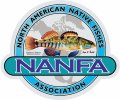Captive Care Notes: Western Chubs (Gila, Family Cyprinidae)
Because of their adaptability and omnivorous diet, most of the smaller western chubs should be easy to keep in aquaria if protected species laws and various state collecting regulations allowed it. The only account of Gila in aquaria that I've seen in the hobbyist literature is from the NANFA publication American Currents. Based on this account, Arroyo Chub (G. orcuttii) are peaceful community tank residents, ceaselessly active, not at all picky about what they eat, and easy to spawn and raise. The author simply placed two males and one female into a 10-gallon tank with hard, alkaline water and found eggs stuck to the gravel and plants a few days later. The eggs were moved to a one-gallon hatching tank whereupon they hatched a couple of days later. The fry were fed infusoria at first, then graduated to baby brine shrimp 3-4 days later.
Aquarists at the Arizona-Sonora Desert Museum in Tucson have been maintaining populations of Gila Chub (G. intermedia) and Sonora Chub (G. ditaenia) for over 15 years. Care for both species is about the same (K. Wintin, pers. comm.). Breeding groups of 100 or more specimens (50 pairs) are maintained outdoors in 300-500 gallon concrete tanks with bare bottoms and depths of 2-3 feet. Water is hard and alkaline with total dissolved solids ranging from 220-350 ppm, salinity between 20-40 ppm, and the pH hanging around 8. Temperatures fluctuate seasonally, from a low of 15C (59F) up to 35C (95F) in the summer. Feedings consist of vegetable flakes, small crickets, brine shrimp twice a week, and one day of fast, except for fry, which are fed crushed flakes and baby (dead) brine shrimp daily. Spawning begins in the spring when water temperatures rise to 24C (75F) and gradually tapers off as the temperature reaches 29C (84F). The chubs will also spawn in the fall at the same temperatures, although not as heavily as in the spring. Frequent water changes of 15-25 percent appear to stimulate spawning. Adults scatter their eggs throughout the tank, with those that end up in algae, vascular plants, or substrate debris being the eggs that hatch. Plant density is directly proportional to fry survival. Since fry congregate near the surface, dense growths of fine-leafed plants that reach the surface are recommended.
At the Belle Isle Aquarium in Detroit, aquarists were surprised to discover that Roundtail Chub (G. robusta robusta) and Rio Grande chub (G. pandora) had spawned behind and between large sandstone slabs along the back and sides of their display tank (D. Sweet, pers. comm.). Aquarists were even more surprised to discover that spawnings also occurred when the two species were pulled off exhibit during renovations and housed in 1500-gallon, U-shaped concrete block tank. A large spray bar, powered by a swimming pool filter, ran down the center at the top of the "U" and virtually covered the entire surface of the water with streams of water jetting into the tank. This surface agitation appeared to be what prompted the chubs to spawn. They deposited eggs all over the tank, especially in the corners, as well as on the walls and even above the water level. Some of the chubs jumped into a bio-ball bucket and spawned in there! The resultant fry -- which may prove to be a hybrid between the two species as they mature -- were raised on brine shrimp nauplii.
At the Ocean Journey public aquarium in Denver, Humpback Chub (G. cypha) and Bonytail (G. elegans) eat a variety of food, including pellets, smelt, shrimp, clams, krill, sardines, and squid (R. Lerner, pers. comm.). At fish hatcheries, Humpback Chub and Bonytail are cultured in raceways. Fry of both species form schools and feed on zooplankton near the surface. As they grow and the zooplankton declines, they are fed 4-5 times a day with a commercial trout starter feed. In rearing ponds, Bonytail can grow at an amazing rate, reaching up to 30 cm (11.8 in) by the end of their first year.
